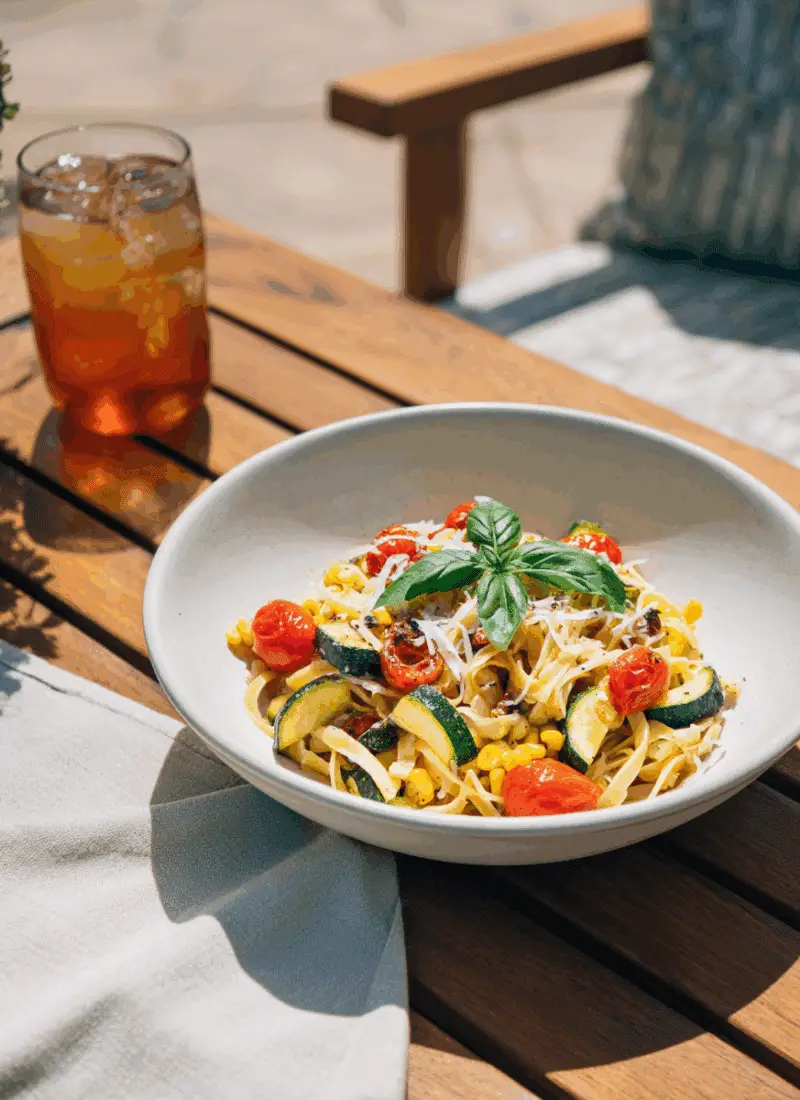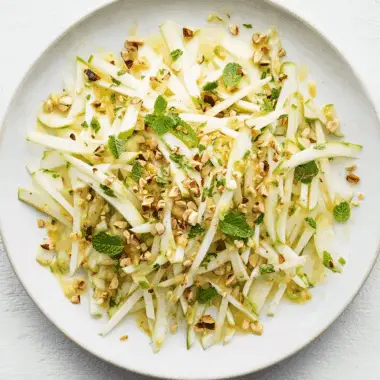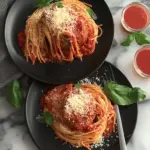A light and colorful pasta dish packed with fresh summer vegetables, perfect for a healthy and vibrant meal.
FULL RECIPE
Ingredients
- 12 oz penne or rotini pasta
- 2 tablespoons olive oil
- 2 cloves garlic, minced
- 1 medium zucchini, sliced
- 1 yellow squash, sliced
- 1 cup cherry tomatoes, halved
- 1 red bell pepper, sliced
- 1 cup fresh corn kernels (or frozen, thawed)
- 1/4 teaspoon red pepper flakes
- Salt and pepper to taste
- 1/4 cup fresh basil leaves, chopped
- 1/4 cup grated Parmesan cheese (optional)
Directions
- Cook pasta according to package instructions until al dente. Drain and set aside.
- Heat olive oil in a large skillet over medium heat. Add minced garlic and sauté for 1 minute until fragrant.
- Add zucchini, yellow squash, and red bell pepper to the skillet. Cook for 5-7 minutes until vegetables are tender.
- Stir in cherry tomatoes, corn kernels, and red pepper flakes. Cook for another 2-3 minutes.
- Season vegetables with salt and pepper to taste.
- Toss cooked pasta with the sautéed vegetables in the skillet until well combined and heated through.
- Remove from heat and stir in fresh basil leaves.
- Serve warm, topped with grated Parmesan cheese if desired.
Nutritional Information (per serving, serves 4)
- Calories: ~320 kcal
- Protein: 8 g
- Carbohydrates: 50 g
- Fat: 8 g
- Fiber: 5 g
- Sugar: 6 g
- Sodium: 220 mg
The Appeal of Summer Veggie Pasta as a Seasonal Favorite
Summer Veggie Pasta stands out as an exceptional dish that captures the essence of the summer harvest. Its vibrant colors and fresh flavors perfectly complement the warmer months when produce is at its peak. This dish is more than just a meal; it’s a celebration of seasonal vegetables that bring nutrition, texture, and a burst of natural sweetness to the plate. The combination of zucchini, yellow squash, cherry tomatoes, and fresh corn ensures a balance of flavors that range from tender and mild to juicy and slightly sweet, creating a harmonious medley that appeals to a wide range of palates. Its light nature makes it especially suitable for those looking for a satisfying yet healthy meal option during hot weather.
Nutritional Benefits and Health Considerations
One of the greatest strengths of Summer Veggie Pasta lies in its nutritional profile. The vegetables incorporated provide essential vitamins and minerals that support overall health. Zucchini and yellow squash are low in calories but rich in vitamin C, potassium, and antioxidants, which contribute to immune support and cellular repair. Cherry tomatoes are well-known for their high lycopene content, an antioxidant linked to heart health and reduced risk of certain cancers. Fresh corn kernels add a subtle sweetness and provide fiber, helping with digestion and maintaining healthy blood sugar levels. The pasta itself offers carbohydrates for energy, and when paired with olive oil, the dish includes healthy fats that aid in nutrient absorption. This balance of macronutrients and micronutrients makes Summer Veggie Pasta a nutritious choice for those mindful of their diet.
Versatility and Customization Options
One of the reasons Summer Veggie Pasta is so popular is its incredible versatility. It can easily be adapted to suit different dietary preferences and tastes. For instance, those following a vegetarian or vegan diet can omit the Parmesan cheese or substitute it with a plant-based alternative to maintain a dairy-free profile. Protein can be added by incorporating grilled chicken, shrimp, or tofu, transforming it into a more substantial main course without sacrificing its fresh appeal. The vegetables can also be varied based on what is locally available or preferred, such as adding asparagus, peas, or spinach for additional nutrients and textures. Herbs like basil, parsley, or oregano can be swapped or combined to change the flavor profile subtly, keeping the dish exciting and new each time it is made.
The Role of Olive Oil and Seasonings
The use of olive oil in Summer Veggie Pasta is not only a nod to Mediterranean culinary traditions but also a health-conscious choice. Olive oil is rich in monounsaturated fats and antioxidants, which are beneficial for heart health and inflammation reduction. When lightly sautéed with garlic, it creates a fragrant and flavorful base that enhances the natural tastes of the vegetables without overpowering them. The inclusion of red pepper flakes adds a subtle heat, balancing the sweetness of the corn and tomatoes while giving the dish a slight kick that stimulates the palate. Seasoning with salt and pepper is kept simple to allow the freshness of the summer vegetables to shine through, making every bite clean and refreshing.
Ideal Serving Suggestions and Pairings
Summer Veggie Pasta is wonderfully flexible when it comes to serving options. It can be enjoyed warm or at room temperature, making it an excellent choice for picnics, potlucks, or quick weeknight dinners. Serving it alongside a crisp green salad or a light soup can create a well-rounded meal. For those who prefer a heartier option, pairing the pasta with a side of garlic bread or a small portion of grilled protein adds variety without complicating the meal. This pasta also pairs beautifully with white wines such as Sauvignon Blanc or Pinot Grigio, which complement the fresh, bright flavors of the vegetables. For non-alcoholic options, a chilled sparkling water infused with lemon or cucumber maintains the light and refreshing theme.
Tips for Preparing the Perfect Summer Veggie Pasta
Achieving the perfect texture and flavor balance is key to making this dish a standout. It’s important not to overcook the vegetables, as their crispness and vibrant color are central to the dish’s appeal. Cooking pasta al dente helps maintain a satisfying bite that contrasts nicely with the tender vegetables. When sautéing, using medium heat ensures the vegetables soften without becoming mushy or losing their natural sweetness. Fresh herbs should be added at the end of cooking to preserve their aroma and flavor. Leftovers should be stored properly in an airtight container and are best consumed within two days to enjoy maximum freshness.
The Environmental Impact of Using Seasonal Vegetables
Choosing to prepare recipes like Summer Veggie Pasta using seasonal and local produce also supports sustainability. Seasonal vegetables generally require less energy to grow and transport, reducing carbon footprints compared to out-of-season imports. Supporting local farmers helps boost local economies and encourages environmentally responsible farming practices. By focusing on fresh summer vegetables, this recipe promotes mindful eating habits that are better for the planet. Additionally, the minimal use of processed ingredients and oils aligns with reducing food waste and packaging waste, making Summer Veggie Pasta a conscious choice for eco-aware consumers.
Conclusion
Summer Veggie Pasta is more than just a colorful, fresh dish; it embodies the spirit of seasonal eating, health-conscious choices, and culinary versatility. Its vibrant combination of fresh vegetables and simple seasonings provides a satisfying yet light meal that appeals to a wide audience. Nutritionally rich and easy to customize, this pasta dish fits perfectly into busy lifestyles without sacrificing flavor or quality. Beyond taste, it encourages sustainable food practices by highlighting seasonal produce. Whether enjoyed as a quick lunch, a light dinner, or a festive addition to a summer gathering, Summer Veggie Pasta remains a delicious and wholesome option worth incorporating into your recipe collection.








